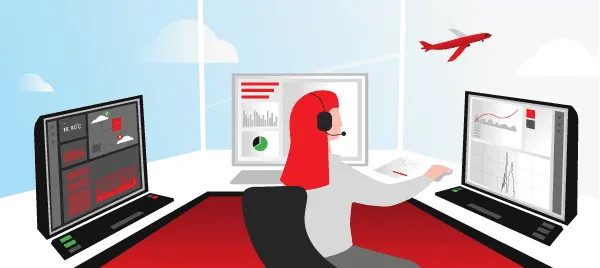
Alexandre Jungo
Co-directeur, responsable informatique et développement, CID ERP
We interviewed Alex Jungo, co-founder and CTO of IT company Fair, to find out more about ERP hosting requirements, migration specifics and cost effectiveness.
1. Tell us about your company.
Founded in 2013 and based in Fribourg (Switzerland), Fair IT is specialised in process analysis and ERP software integration: CID ERP.
CID ERP is a powerful, scalable and ergonomic business management software for SMEs, institutions, industries and large companies.

The CID ERP management solution covers all the classic areas of management and offers specific functions for different sectors of activity. The solution is highly adaptable thanks to simple configurations and adapts to the needs of the company, not the other way around. A customised module can be added to the existing range of functions at any time. This represents a real advantage in terms of adaptability and scalability.
No more days of downtime with imperfect migration scripts, CID ERP is delivered to the customer in a continuous form with automated update scripts.
2. What software and applications are you using to carry out the project? Why did you choose them and how do they solve the assigned tasks?
CID ERP is delivered in SaaS mode to its customers. The software is developed in Python and the application server is based on a Debian-based docker container.
A Nginx node (Jelastic certified) handles incoming requests and secures the traffic with SSL.
A PostgreSQL container (Jelastic certified) is used as a database management server.
A storage container is used to store client files.
A simple client environment consists of each of these 4 containers.
The deployment of a new environment is fully automated using the Jelastic cloud script.
3. What are your and your customers’ requirements for cloud hosting?
The initial specifications were quite long, here are the fundamental points.
One of the important elements in the choice of hosting is its location and security: indeed, a Swiss location is required for reasons of data protection and sometimes regulation. The security of the chosen solution, its robustness, its fault tolerance, its rapid recovery in the event of an incident and its backup are also essential.
Independence in the management of client environments is another important point: not having to call the cloud provider to make changes is necessary and the Jelastic console perfectly meets this need for independence.
The automation of deployment, update and maintenance actions has allowed us to industrialise our processes.
An efficient, fast and close support site is necessary to ensure the quality follow-up we want for our customers.
4. Which hosting solutions did you use before? What difficulties did you encounter with them?
We had an IaaS infrastructure with Linux VMs based on HyperV.
We experienced many stability issues due to compatibility problems between HyperV and Linux.
We had no autonomy in setting up a VM and sometimes had to wait several weeks for a new VM between the business and delivery processes.
Working on such an infrastructure would be impossible today with the new customers that come to our software every week.
5. Why did you decide to choose Jelastic PaaS? What benefits helped you make this decision and what results are you getting now?
We chose Jelastic and Hidora because the tool and the host met all the criteria of our specifications.
Hidora competently showed us the power of Jelastic. We made a functional Proof of Concept in one afternoon with the Hidora team.
We quickly set up tests and then ran our own production ERP on Jelastic. Fully satisfied with the results, we progressively migrated our customers to the system, validating that it did not cause load problems, which was not the case.
We have gained in autonomy, in speed of execution, in stability, in automation capacity, in short, we have gained in all respects. Not to mention the competence and responsiveness of the Hidora support team, which assists us on a daily basis in our operational activities.
6. Why did you decide to use a local service provider? What is the role of personal and sensitive data regulation in your company?
The Swiss localisation of the data was above all a guarantee of data protection for our clients. Some of them are obliged to keep their data in Switzerland for legal or regulatory reasons.
The choice of a local provider also offers proximity, personal contact, regular meetings; in short, the human contact necessary to work as a team, represented on the one hand by our internal DevOps developers, and on the other hand by Hidora’s system specialists, with the support of Jelastic, at the service of our customers.
7. What do you think about containerisation? What difficulties (if any) have you encountered in migrating from a VM-based infrastructure to a container-based infrastructure? How are you currently managing containers?
We didn’t have any difficulties because we already had a Docker container infrastructure before, the VM was acting as a host for the Docker containers. It didn’t change our infrastructure radically.
8. What do you think of Jelastic’s pay-per-use model? Describe cases where the total cost has been reduced by this model.
Overall, we have reduced our customers’ infrastructure costs by ¾. Some of the high-volume customers themselves benefited from ½ of the cost reduction. Some customers with many employees had to have a large VM with 8 vCPUs, for example, when they were only using those cores for a few hours a month. So the cost reduction comes from charging fairly for resources used rather than resources reserved.
Now that we have a few years of experience with costs on Jelastic, it’s easy to give the customer a realistic cost range. When we first started using the platform, it was difficult to know well in advance what the cost to the customer would be. This could have led to some fear that costs would explode, but this was clearly not the case, on the contrary.
9. Share your future plans for the project and for cooperation with Jelastic Provider.
We are in the process of implementing a fully automated ERP update system, which can be triggered at the request of the customer, the project manager or regularly scheduled such as once a month.
Currently, we initiate updates via a Jelastic manifest: these are tasks performed by DevOps developers for production machines or project managers for non-productive machines. This takes time and our customers want to be able to decide on the update themselves. The ERP is ready for this, it remains for Hidora and ourselves to code an automation from the customer’s update request to the implementation, including a test step to validate that the operation will be completely successful. The implementation of an automatic roll-back system in case of failure will also be essential.
10. Please describe your stack, types of environments, architecture if possible.
For each environment (client) :
1x Nginx
1x Debian application server, Python application
1x PostgreSQL
1x storage
11. Highlight three main points that you like about Jelastic PaaS.
Complete autonomy in use -> significant time saving
Relationship with a local hosting provider -> focus on what everyone does best + availability and competence of the provider
Automation possible via cloud-scripting -> significant time saving









